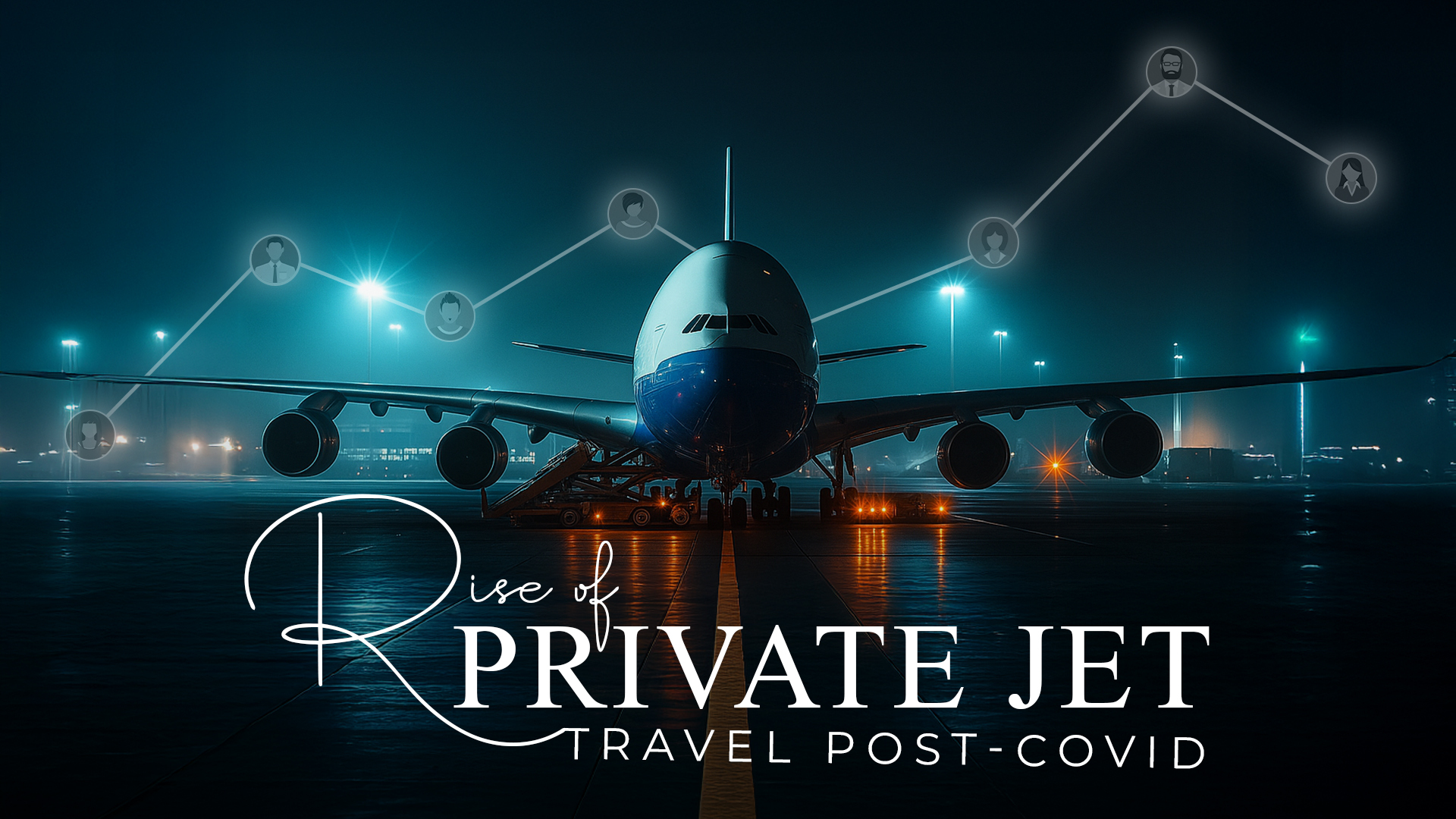- By Admin
- 17 July, 2025
- 8 min Read
The Rise of Private Jet Travel Post-COVID
The COVID-19 pandemic disrupted the global aviation industry in unprecedented ways. While commercial airlines faced grounded fleets, slashed routes, and financial instability, private aviation quietly experienced a surge in demand. Once perceived as a niche reserved for the ultra-wealthy, private jet travel became a practical and safer alternative during the pandemic—and this shift appears to be lasting.
This blog explores the core factors that led to the rise in private jet travel post-COVID, analyzes the state of the market in 2025, and examines how emerging trends such as sustainability, digital transformation, and geopolitical influences are reshaping the future of luxury aviation.
Key Factors That Led to the Increase in Private Jet Travel
The pandemic accelerated a behavioral shift in how travelers—particularly those with means—approached mobility. Several key drivers explain the rapid rise in private jet usage:
- Health and Safety Prioritization: Travelers sought to minimize exposure to crowded airport terminals and commercial aircraft. Private jets allowed limited interaction with personnel, reducing COVID-19 transmission risk significantly.
- Reduced Commercial Flight Availability: Commercial airlines drastically cut back on flights and destinations. This created significant gaps in connectivity, pushing travelers to seek alternatives, especially for business continuity and urgent travel.
- Demand for Scheduling Flexibility: Constantly changing travel restrictions and border policies required flexible travel plans. Private jets enabled passengers to control their itineraries with minimal disruption.
- Remote Work Culture: The rise in location-independent work created a new class of travelers who prioritized flexibility. High-net-worth individuals and executives began using private aviation for spontaneous relocations, business travel, or extended stays in remote locations.
Together, these factors redefined private aviation from a luxury to a necessity for a growing segment of global travelers.
Private Jet Market Analysis 2025: What the Numbers Reveal
The expansion of private jet travel post-COVID is more than anecdotal—market data confirms a sustained upward trajectory.
- Global Market Size: The private jet market is forecasted to surpass USD 40 billion by the end of 2025, growing at a compound annual growth rate (CAGR) of 5.2% since 2021.
- Flight Activity: Business aviation activity in regions like North America and Europe remains 10–15% above pre-pandemic levels, driven by a mix of leisure travel and corporate demand.
- Fleet Expansion: Aircraft manufacturers report growing order backlogs. Light and midsize jets are particularly in demand due to their cost efficiency and operational flexibility.
- New User Demographics: Notably, up to 30% of charter bookings in 2024 came from first-time private flyers, indicating broader acceptance and usage across age groups and sectors.
With these figures, it’s clear that private jet travel is not reverting to pre-COVID norms—it’s establishing a new baseline.
Sustainability: A Turning Point for Private Aviation
While growth has brought new opportunities, it has also intensified scrutiny—especially regarding environmental impact. The post-COVID period marks a critical turning point in the industry's approach to sustainability.
- Adoption of Sustainable Aviation Fuel (SAF): SAF adoption is gaining momentum. Compared to conventional jet fuel, SAF offers up to 80% lifecycle emissions reduction.
- Carbon Offsetting Initiatives: Operators are increasingly integrating carbon offset programs that support renewable energy, afforestation, and conservation projects.
- Electric and Hybrid Aircraft Development: Investment in electric and hybrid aviation is surging. eVTOLs (electric vertical takeoff and landing aircraft) and hydrogen-powered engines are under active development, with expected real-world applications by the early 2030s.
The industry is evolving, with sustainability becoming both a regulatory necessity and a core aspect of brand identity.
COVID-19’s Effect on the Airline Industry
To fully understand the rise of private aviation, it’s important to contrast it with what commercial airlines experienced during and after COVID-19:
- Passenger Traffic Collapse: In 2020 alone, global passenger demand dropped over 75%, resulting in record losses for airlines.
- Route Reductions and Fleet Groundings: Many international routes were suspended, and older aircraft were retired early. This created connectivity gaps, particularly in secondary cities.
- Accelerated Digitalization: Airlines adopted digital boarding, biometric screening, and no-touch services to rebuild traveler confidence, but recovery has been uneven across regions.
These developments pushed many travelers—especially business leaders and HNWIs—to seek alternatives, with private jets filling the void left by shrinking commercial options.
Economic and Geopolitical Influences
Beyond pandemic dynamics, broader economic and political forces continue to shape the private jet industry:
- Global Wealth Growth: The number of ultra-high-net-worth individuals (UHNWIs) is increasing, particularly in Asia, the Middle East, and Africa. This directly fuels demand for personalized air travel.
- Regional Instability and Security Concerns: Geopolitical tensions, including the Russia-Ukraine war and Middle East unrest, have prompted secure charter travel for business leaders, diplomats, and relief operations.
- Tax Policy and Ownership Incentives: In markets like the U.S., aircraft ownership has been incentivized through tax advantages such as accelerated depreciation, encouraging long-term investment in private aviation.
These factors collectively position private jets as strategic assets, not merely luxury indulgences.
Infrastructure Development: Enabling the Growth
Supporting this rise is an equally significant expansion in private aviation infrastructure:
We support:
- Fixed-Base Operators (FBOs): The number of FBOs—private terminals for business jets—has grown steadily, offering quick security checks, exclusive lounges, and concierge support.
- Improved Regional Connectivity: Smaller regional airports are seeing higher traffic as they offer direct access to destinations not served by major carriers.
- Enhanced Maintenance & MRO Facilities: Expanded global MRO (Maintenance, Repair, Overhaul) capacity is reducing aircraft turnaround times and improving reliability.
This infrastructure development not only accommodates growing demand but also makes private aviation more accessible and efficient.
Technological Advancements and Digital Transformation
The private aviation sector is undergoing rapid digitization—transforming the passenger experience and operational efficiency.
- Real-Time Charter Platforms: On-demand booking apps now provide live pricing, aircraft availability, and instant confirmations, democratizing access to private flights.
- Predictive Maintenance Technologies: AI and IoT-based systems monitor aircraft health and usage data to anticipate maintenance needs, minimizing downtime and enhancing safety.
- Personalized Inflight Services: Data-driven personalization enables everything from customized menus to entertainment options tailored to passenger preferences.
Digital transformation is no longer optional—it’s central to competing in a rapidly evolving aviation ecosystem.
Sustainability and Green Aviation Initiatives: The Road Ahead
As the industry grows, the focus on environmental responsibility deepens:
- Green Airport Infrastructure: Airports are integrating solar energy, EV charging for ground vehicles, and sustainable construction materials in FBOs and hangars.
- Fleet Modernization: Operators are phasing out older, less fuel-efficient aircraft, replacing them with newer models boasting up to 20% improved fuel economy.
- Regulatory Pressure: Organizations like ICAO and EASA are pushing for emissions targets, and some regions may soon require mandatory SAF usage for chartered flights.
Sustainability is no longer a peripheral concern—it’s becoming central to the industry’s license to operate in the decades ahead.

